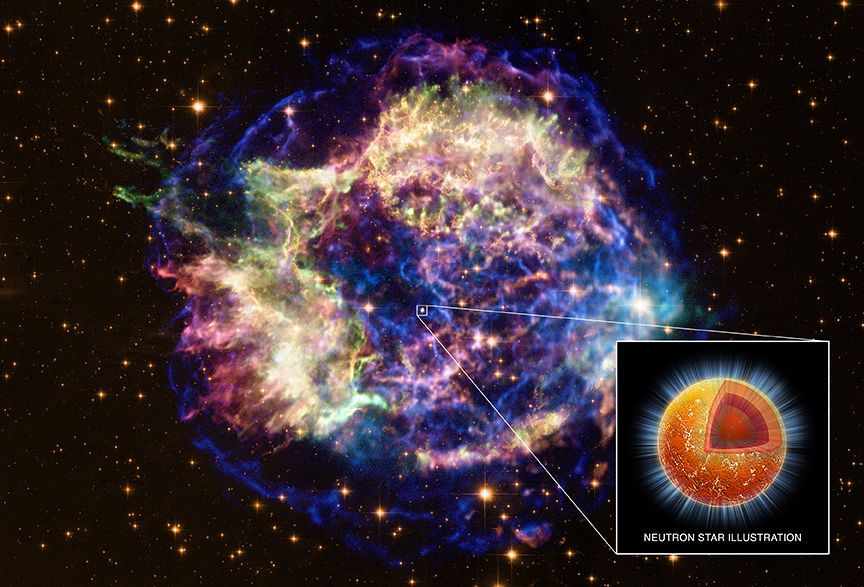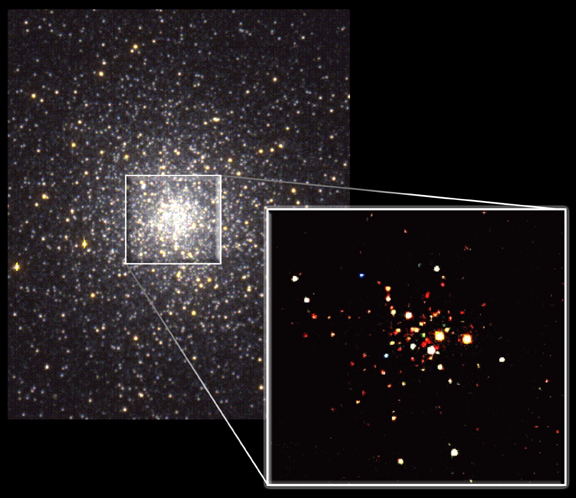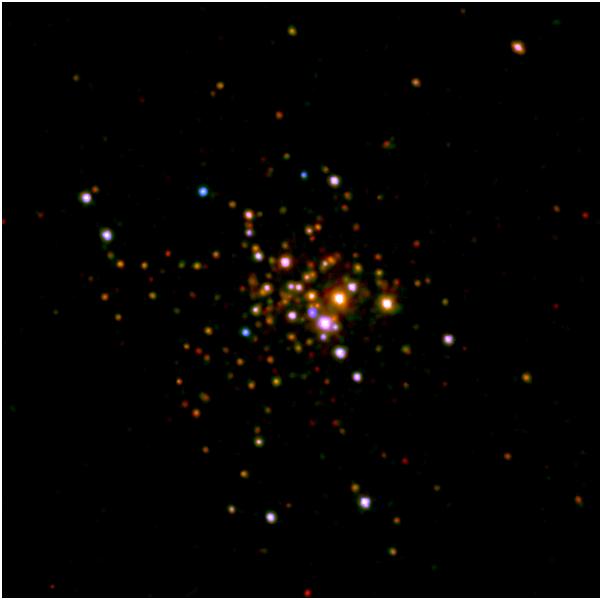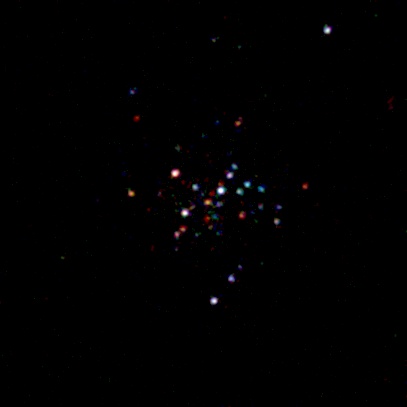


Craig Heinke
Associate Professor of Physics
Department of Physics
University of Alberta
CCIS 4-183
Edmonton, AB T6G 2E1
phone: (780) 248-1432
email: heinke $at$ ualberta.ca
fax: (780) 492-0714
Office: CCIS 2-109 (north side, 2nd floor)
Craig's Research
Chandra X-ray & HST optical image of Cassiopeia A, NASA/CXC/D. Page/P. Shternin
 |
I study "dead" stars, which have used up their fuel and come to the end of their normal lives; these include white dwarfs, neutron stars, and black holes. X-ray binaries are compact stars accreting matter from a (more normal) companion star; this stellar vampirism produces strong X-ray radiation as the matter falls to the compact object's surface. I have focused in particular on X-ray binaries containing neutron stars, using X-ray telescopes such as the Chandra X-ray Observatory to collect and study X-rays from these objects. My scientific interests also include globular clusters, millisecond radio pulsars, the Galactic Center, and supernova remnants.
Supernova remnants
My colleague Wynn Ho and I discovered a carbon atmosphere on the neutron star in the Cassiopeia A (Chandra/HST image at right) supernova remnant (Ho \& Heinke 2009, Nature, 462, 71); details are here.
We recently found evidence that neutron stars contain superfluids in their cores, from observations of the cooling of the Cas A neutron star (Shternin et al. 2011, MNRAS, 412, L108; Heinke \& Ho, 2010, ApJ, 719, L167). For details see here.
Another collaboration which I was involved with discovered gamma-ray flaring from the Crab Nebula (Tavani et al. 2011, Science, 331, 736). For details see here.
Globular clusters
47 Tuc: ESO/W. Keel optical, Chandra X-ray
 |
Globular
clusters such as 47 Tucanae (47 Tuc) are the homes of thousands to millions of stars.
The left image shows a ground-based photo; 47 Tuc is one of only two
globular clusters that can be seen from the ground with the naked eye
(unfortunately, only from the Southern Hemisphere!). The right image
shows an X-ray observation of 47 Tuc with Chandra.
The two brightest objects are quiescent low-mass
X-ray binaries containing neutron stars. Low-mass X-ray binaries
are compact objects (black holes or neutron stars) pulling matter from
a star in orbit around them; as this matter is sucked down onto the
compact star, it emits X-rays. In quiescence, we probably don't
see matter continuing to fall onto the neutron star, but rather the
neutron star surface, still hot from the last episode of
accretion.
Many of the other bright objects are cataclysmic
variables--white dwarfs pulling matter from a companion star.
Dozens of the faint red objects are millisecond
radio pulsars. Radio pulsars
are fast-spinning neutron stars that emit radio pulses once (or twice)
per spin, as their magnetic pole(s) faces towards Earth. Millisecond
pulsars spin faster than 100 times per second, and are believed to have
reached these fast spin rates by accreting matter from a companion
star. They should thus be descendants
of low-mass X-ray binaries. Finally, the largest number of
(usually faint) X-ray sources are pairs of normal stars. Even
stars like our Sun emit X-rays,
but rather faintly. The stars visible in X-rays in 47 Tuc have
are in binary
systems where both stars are tidally locked facing each other (like
our moon to the Earth). They are thus forced to spin more rapidly
than they would otherwise, and this rapid spin induces greater X-ray
activity.
See Grindlay et al. 2001a, Science 292, 2290, and the NASA
press release.
47 Tuc: NASA/Chandra image, J. Grindlay & C. Heinke |
Terzan 5: NASA/Chandra image, C. Heinke |
A deeper image of 47 Tuc (left), showing some of 300 X-ray sources. In
true-color x-ray images like this, red indicates lower-energy photons,
blue higher-energy photons. This dataset has produced numerous results, including the identification of a neutron star that has recently become an active radio pulsar, due to accreting matter from its companion; see 2005 NASA press release.
To right, Chandra image of the globular cluster Terzan 5. Terzan 5
(located near the Galactic center) is roughly twice as far from us as
47 Tuc, and is hidden behind substantial dust and gas. Terzan 5
is a denser cluster than 47 Tuc, and the interactions between stars in
the center of the cluster have produced additional X-ray
binaries, and their millisecond pulsar descendants. Terzan 5 has the largest known numbers of radio millisecond pulsars of any globular cluster, and may also have the richest collection of X-ray binaries.







